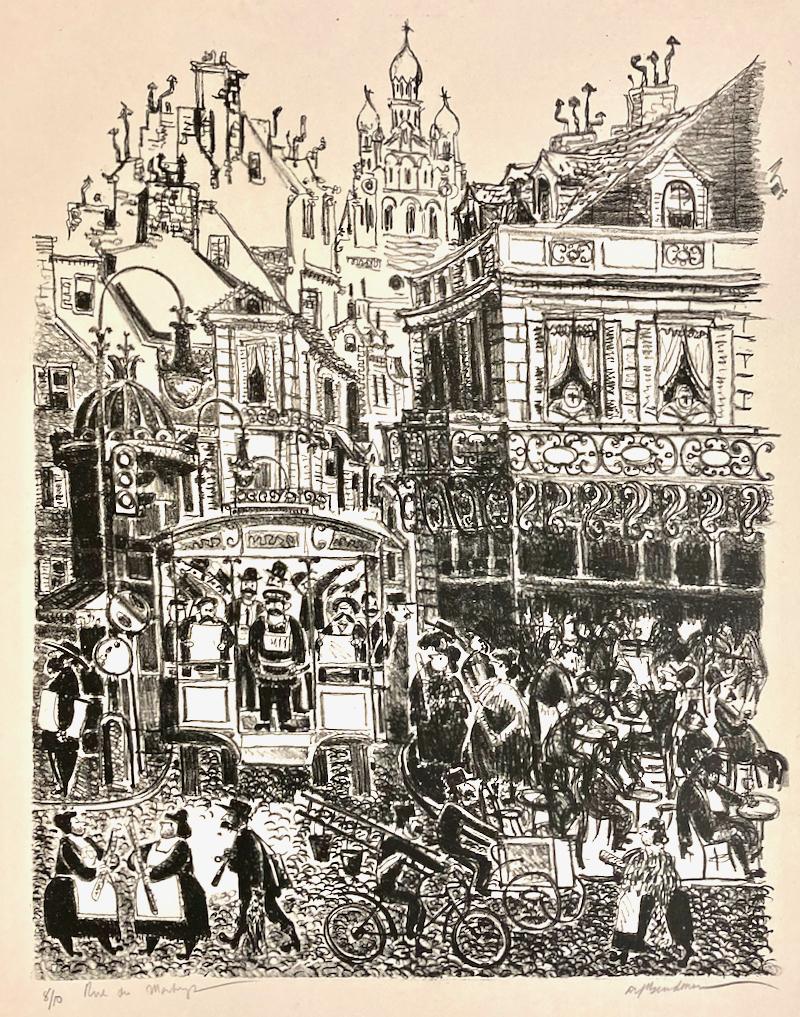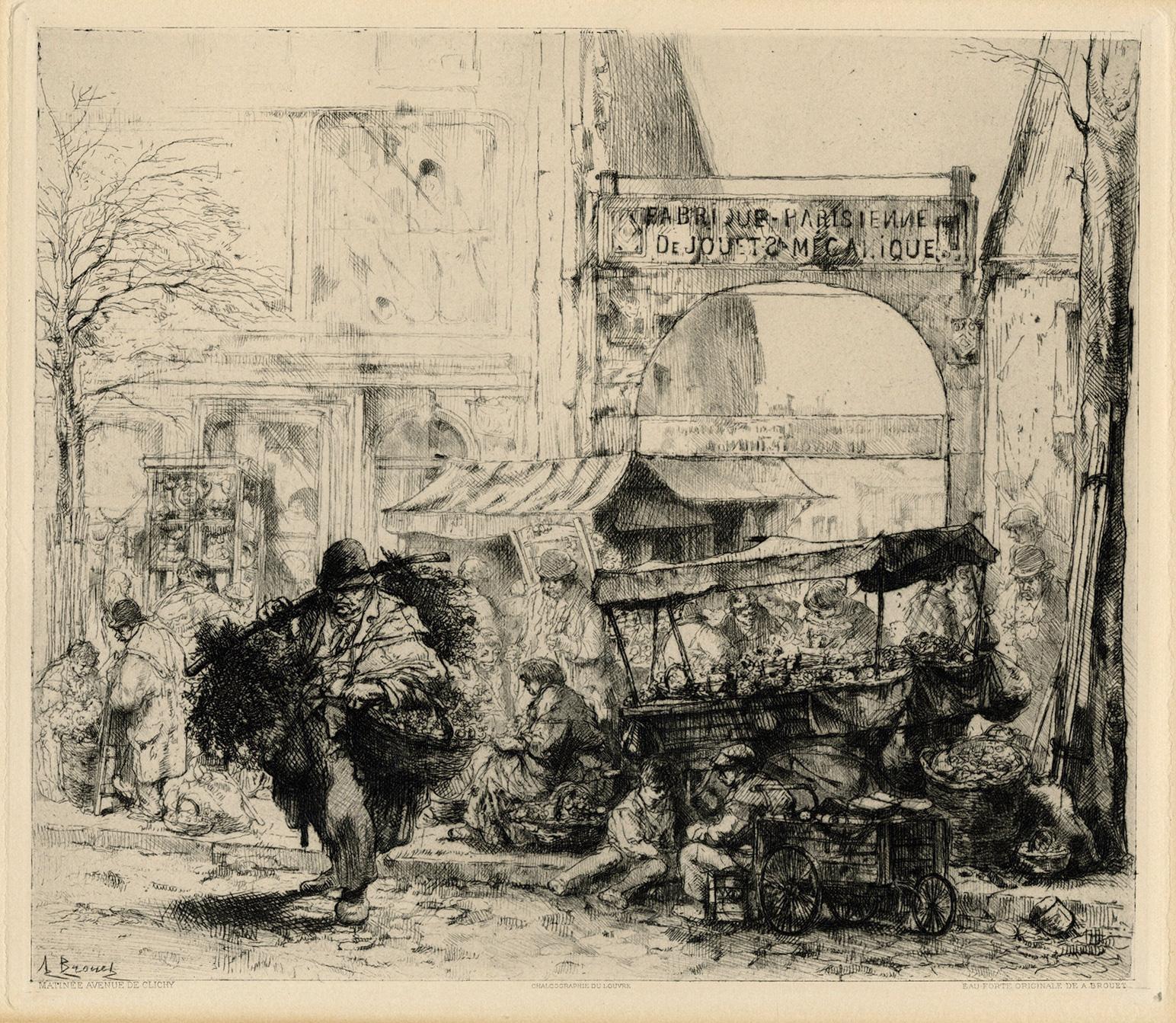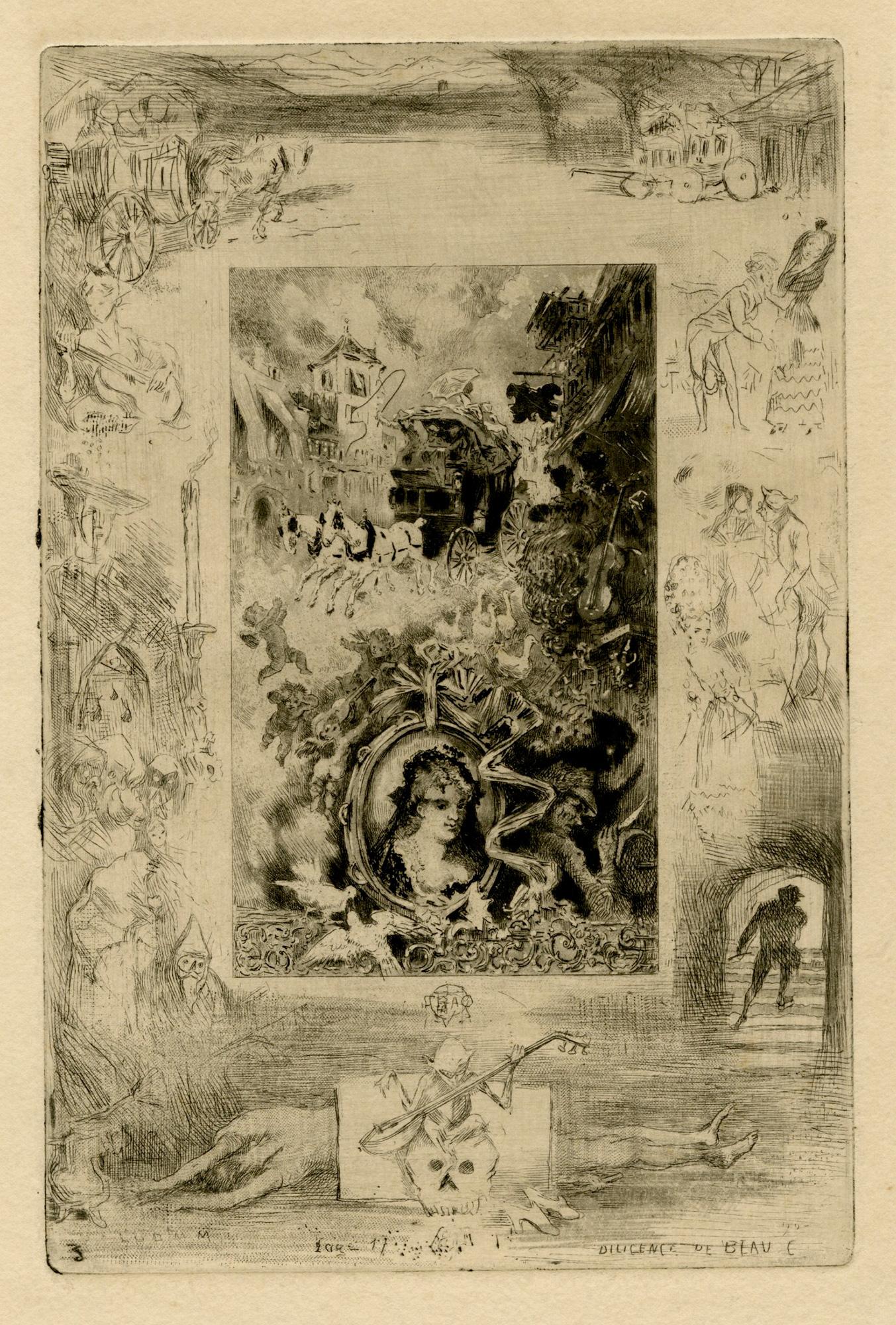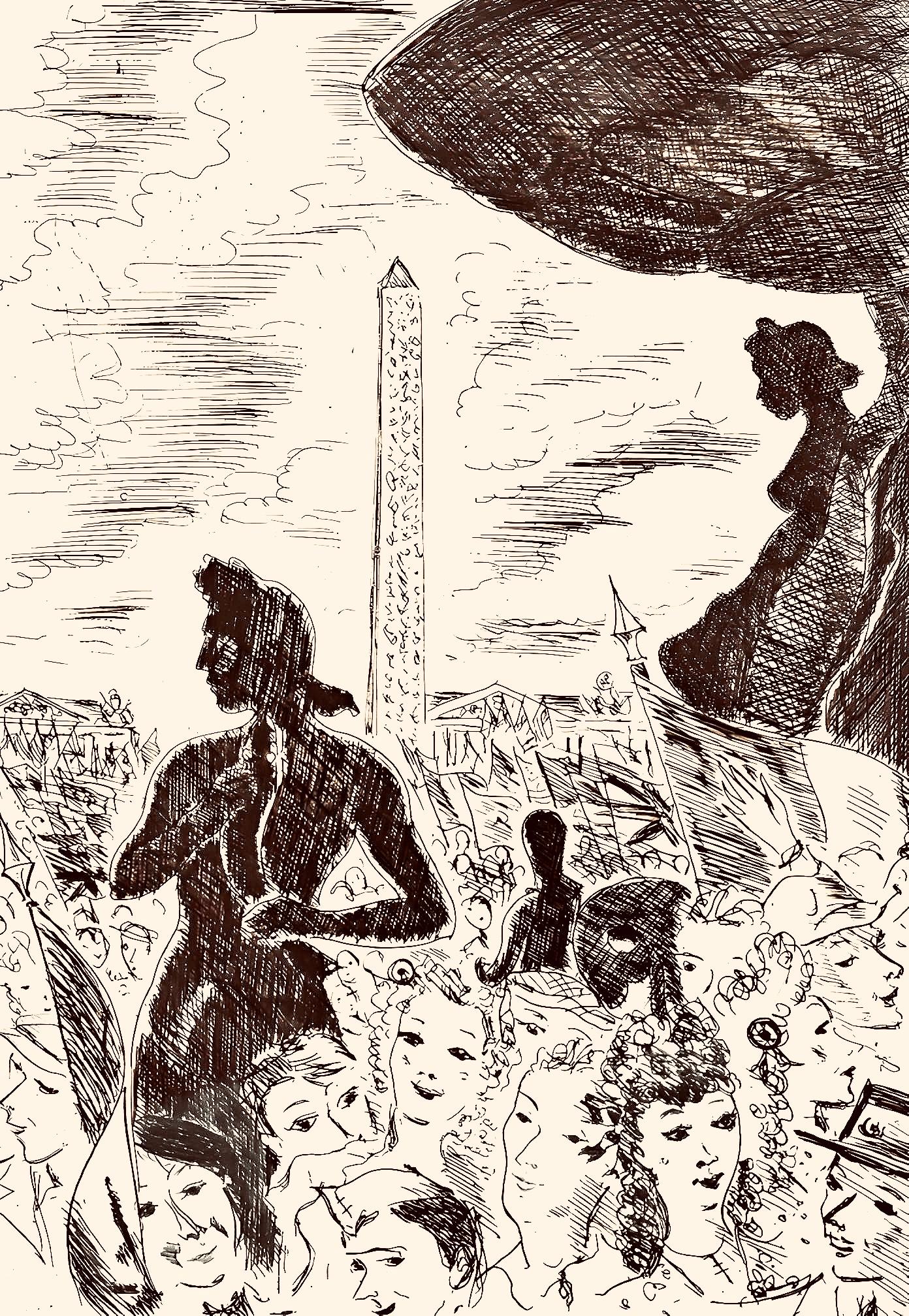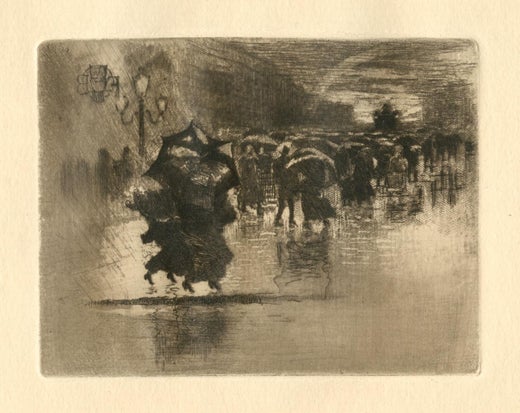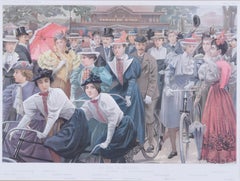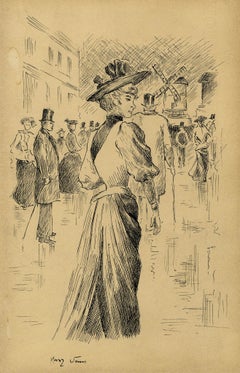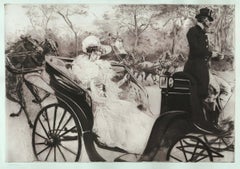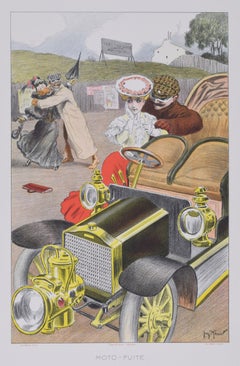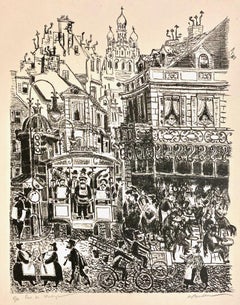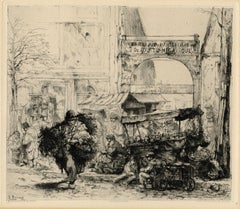Items Similar to La Fête Nationale du Boulevard Clichy
Want more images or videos?
Request additional images or videos from the seller
1 of 9
Félix Hilaire BuhotLa Fête Nationale du Boulevard Clichy1878
1878
$2,500
£1,903.75
€2,173.96
CA$3,512.81
A$3,854.22
CHF 2,030.22
MX$45,850.02
NOK 26,006.85
SEK 23,747.81
DKK 16,241.57
About the Item
La Fête Nationale du Boulevard Clichy
Etching, drypoint, and aquatint, 1878
Signed lower left in the plate (see photo)
Printed chine collee, mounted on white wove paper
Upper plate mark weak from printing
Condition: Upper plate mark weak from printing
very clean and rich impression
Image/Plate Size: 12 1/2 x 9 1/4" (31.75 x 23.50 cm)
Sheet size: 17 1/8 x 13 inches
Reference: Bourcard/Goodfriend 127 vi/VIII, "with the arms of the city..."
very clean and rich impression
According to Goodfriend, " The holiday, one will notice from the inscription, is June 30, not July
14, for this is before Bastille Day was made the official French national holiday. "
Some have made the association of the similar subject matter and composition to the "Flag Paintings" and lithographs by the American artist Childe Hassam (1859-1935) created in 1910.
Félix-Hilaire Buhot
French, 1847 - 1898
Among the most original prints made in France during the last quarter of the nineteenth century are those by Félix Buhot. Born in 1847 in the small Normandy town of Valognes, in northern France, Buhot moved to Paris in 1865, where a year later he enrolled in the École des Beaux-Arts, studying painting and drawing under various artists. Buhot first learned to etch in about 1873, producing his first etching later that year and quickly establishing himself as a successful printmaker. The young artist made his living by decorating fans and illustrating lithographic sheet music. Buhot lived and worked most of his life in Paris, with frequent visits back to northern France and extended trips to England where he met his wife, Henrietta Johnston, whom he married in 1881. By 1892 Buhot had ceased making prints, and in 1898, after suffering prolonged bouts of deep depression, he died at the age of fifty-one.
Along with Edgar Degas and Camille Pissarro, Félix Buhot numbers among the most experimental printmakers of his day. In exploring the unique aspects of etching, he developed an approach to printmaking that was very painterly; in fact he called his prints "paintings on copper." A true printmaker's printmaker, Buhot delighted in all the technical variables and regularly combined multiple processes to produce a single print: he achieved even greater tonal variation by employing the more traditional techniques of etching, drypoint, and aquatint along with several less familiar methods. Unlike many contemporary printmakers who disliked photography, Buhot heartily embraced the medium and used it as a creative aid. He also used different inks and papers for varied effects. His most original contribution to the history of printmaking is a device he termed marges symphoniques (symphonic margins): by amplifying the main subject, such illustrations became an integral part of the print.
In his many prints of city views and seascapes, Buhot was intent on creating a specific atmosphere, especially the effects of weather such as rain, snow, mist, and fog. He turned to his immediate neighborhood in and around the boulevard de Clichy in Montmartre, Paris, for inspiration for his prints of everyday city life. Buhot delighted in portraying the varied street life of the vibrant capital city not only in different seasons (Winter in Paris, 1879) but also in moments of public display, from a festive holiday celebration (National Holiday on the Boulevard de Clichy, 1878) to a somber death observance (Funeral Procession on the Boulevard de Clichy, 1887). His city views also include London scenes (Westminster Palace and Westminster Bridge, both of 1884). And Buhot's love for the sea is evidenced in the many prints exploring its ever-changing atmospheric conditions and moods. Buhot's boat trips to England inspired two of his most characteristic prints, A Pier in England and Landing in England, both from 1879.
With his experimental printmaking techniques, Buhot became one of the best-known, admired, and collected printmakers of his day. He achieved success for his prints at the annual Salons between 1875 and 1886, and a number of his works were published in leading periodicals and books. He also found critical acclaim and support for his prints in the United States, especially after his first one-man exhibition organized by the New York print dealer Frederick Keppel in 1888.
Courtesy: National Gallery of Art, Washington, D. C.
- Creator:Félix Hilaire Buhot (1847 - 1898, French)
- Creation Year:1878
- Dimensions:Height: 12.5 in (31.75 cm)Width: 9.25 in (23.5 cm)
- Medium:
- Movement & Style:
- Period:
- Condition:
- Gallery Location:Fairlawn, OH
- Reference Number:Seller: FA82051stDibs: LU14014197142
Félix Hilaire Buhot
Buhot’s prints were made at a time of renewed interest in original printmaking (especially etching), which was rapidly becoming more popular than reproductive engraving. His etchings were singled out for praise as early as 1874 by the preeminent critic Philippe Burty, who admired the artist’s belles épreuves (beautiful proofs)— a term Burty promoted to denote rare, superbly inked impressions printed by the artist himself. By the 1880s Buhot had become one of the best-known and most collected printmakers of his day. Buhot’s renown extended well beyond his own country, and he also enjoyed critical acclaim and strong support for his prints in the United States. In 1888 the New York print dealer Frederick Keppel (1845-1912) gave Buhot his first one-man exhibition, which was quite successful. In addition to Keppel, Buhot became friends with two prominent late nineteenth-century American collectors who amassed large numbers of the artist’s prints: Samuel P. Avery (1822-1904) of New York collected over 300 prints and George A. Lucas (1824-1909) of Baltimore owned some 200 prints. Beginning in 1911, another large collection was formed by Albert H. Wiggin (1868-1951) of Boston, who bought over 150 impressions. Today, these collections can be found in, respectively, the New York Public Library, the Baltimore Museum of Art, and the Boston Public Library.
About the Seller
5.0
Recognized Seller
These prestigious sellers are industry leaders and represent the highest echelon for item quality and design.
Gold Seller
Premium sellers maintaining a 4.3+ rating and 24-hour response times
Established in 1978
1stDibs seller since 2013
835 sales on 1stDibs
Typical response time: <1 hour
Associations
International Fine Print Dealers Association
- ShippingRetrieving quote...Shipping from: Akron, OH
- Return Policy
More From This Seller
View AllAu Bois De Boulogne (illustrating the congregation of French nobility outside
Located in Fairlawn, OH
Au Bois De Boulogne (illustrating the congregation of French nobility outside the Chalets du Cycle
Chromolithograph, 1897
Signed in the plate lower right corner
From the Special Supp...
Category
1890s Art Nouveau Figurative Prints
Materials
Lithograph
Night Life at the Moulin Rouge
By Henry Somm
Located in Fairlawn, OH
Night Life at the Moulin Rouge
Pen and ink drawing, c. 1890
Signed lower left (see photo)
A scene of the night life near the Moulin Rouge, Paris. The Moulin Rouge is the famous caba...
Category
Late 19th Century French School Drawings and Watercolor Paintings
Materials
Ink
La Promenade
By Edgar Chahine
Located in Fairlawn, OH
La Promenade
Etching, soft-ground, aquatint & drypoint,
Signed in pencil lower left
Published by Edmund Sagot, Paris
Edition of 50 in black only, aside from the edition of 50 in co...
Category
Early 1900s Art Nouveau Figurative Prints
Materials
Drypoint, Etching, Aquatint
Moto-Fuite
By Georges Meunier
Located in Fairlawn, OH
Moto-Fuite
Color lithograph, c. 1902
Signed in the stone lower right (see photo)
Published by Edmund Sagot (1857-1917), Paris
Printed by Atelier Chaix, Paris
Large edition with titl...
Category
Early 1900s Art Nouveau Figurative Prints
Materials
Lithograph
Un Debarquement en Angleterre (A Disembarking in England)
By Félix Hilaire Buhot
Located in Fairlawn, OH
Un Debarquement en Angleterre
(A Disembarking in England)
etching, drypoint, aquatint, roulette and spirit ground, 1879
Signed with the artist’s red owl stamp, Lugt 977 (see photo)
...
Category
1870s Impressionist Landscape Prints
Materials
Drypoint
Moto-Flirt
By Georges Meunier
Located in Fairlawn, OH
Moto-Flirt
Color lithograph, c. 1902
Signed in the stone lower right (see photo)
Published by Edmund Sagot (1857-1917), Paris
Printed by Atelier Chaix, Paris
Large edition with title...
Category
Early 1900s Art Nouveau Figurative Prints
Materials
Lithograph
You May Also Like
Alfred Bendiner, Rue des Matrys (Paris)
By Alfred Bendiner
Located in New York, NY
World traveler that he was, Bendiner was clearly at home in Paris. He found everyone fascinating and has made this print a compendium of local characters and types. Nothing escapes h...
Category
1950s American Modern Landscape Prints
Materials
Lithograph
Matinée Avenue de Clichy
By Auguste Brouet
Located in Middletown, NY
Drypoint etching on buff wove paper, 9 1/2 x 10 3/4 inches (240 x 271 mm) full margins. Signed in the image, lower left. With the "Musée Louvre Chalcographie" blind stamp in the lowe...
Category
Early 20th Century French School Landscape Prints
Materials
Handmade Paper, Drypoint, Etching
Sortie de Theatre a Londres
By Jean-Emile Laboureur
Located in New York, NY
Jean-Emile Laboureur (1877-1943), Sortie de Theatre a Londres, etching and drypoint, 1911, signed in pencil lower left [also signed and dated in the plate upper right]. Reference: Laboureur 104, third state (of 3). Published for La Societe des amis de l’eau-forte, with the blindstamp with the inscription: Circle Librairie Estampes. From an edition in the third state of 109; there were also 5 impressions of the first state and five of the second state. In excellent condition, the full sheet with deckle edges bottom and sides, 6 3/4 x 14; a remarque lower left 2 x 3 1/2, the sheet 12 3/4 x 19 3/4 inches.
Provenance: unknown collector’s mark verso (GOE in oval)
A fine rich impression, printed in dark brown ink on cream laid paper with the Arches watermark.
The small remarque lower left is actually another print printed on a separate plate; it shows a man running after a London horse...
Category
1910s Naturalistic Figurative Prints
Materials
Drypoint
La diligence de Beaucaire
By Félix Hilaire Buhot
Located in Middletown, NY
Paris: Lemerre, 1880.
Etching, drypoint, aquatint (dust ground and spirit ground), spit bite, and roulette in black on cream laid paper with a deckle edge, 6 3/4 x 4 1/2 inches (170 x 112 mm), full margins. Third state (of 3). An illustration from Alphonse Daudet's, Lettres de mon moulin, Paris, 1880. In very good condition with some light uniform toning and two areas of paper tape at the top right and left corners on the verso (from a former mount). With the 1921 J.H. de Bois circular ink stamp in green ink in the lower right margin on the recto (Lugt L.733).
[Bourcard 110].
A note regarding the provenance:
J. H. de Bois was a well known late-19th century modern art...
Category
1880s French School Interior Prints
Materials
Laid Paper, Drypoint, Etching, Aquatint
Touchagues, Jours de gloire, Histoire de la libération de Paris (after)
By Louis Touchagues
Located in Southampton, NY
Etching on papeteries vélin de Lana paper. Inscription: unsigned and unnumbered, as issued. Good condition, with full margins. Notes: From the folio, Jours de gloire, Histoire de la ...
Category
1940s Modern Landscape Prints
Materials
Etching
$716 Sale Price
20% Off
Free Shipping
Dignimont, Jours de gloire, Histoire de la libération de Paris (after)
By André Dignimont
Located in Southampton, NY
Etching on papeteries vélin de Lana paper. Inscription: unsigned and unnumbered, as issued. Good condition, with full margins. Notes: From the folio, Jours de gloire, Histoire de la ...
Category
1940s Modern Landscape Prints
Materials
Etching
$716 Sale Price
20% Off
Free Shipping
More Ways To Browse
Palace Of Westminster
Funeral Procession
Kaws Signed Print
Kayla Mahaffey
Keith Haring 1991
Keith Haring Dog
Keith Haring Paradise Garage
Kenneth Washburn
Ladislav Sutnar
Leroy Neiman Olympic Art
Leroy Neiman Original Art
Les Saltimbanques
Malcolm Morris
Marc Chagall La Place De La Concorde
Marc Daniel
Marquis De Sade Dali
Martin Katz
Matisse Signed Lithograph
